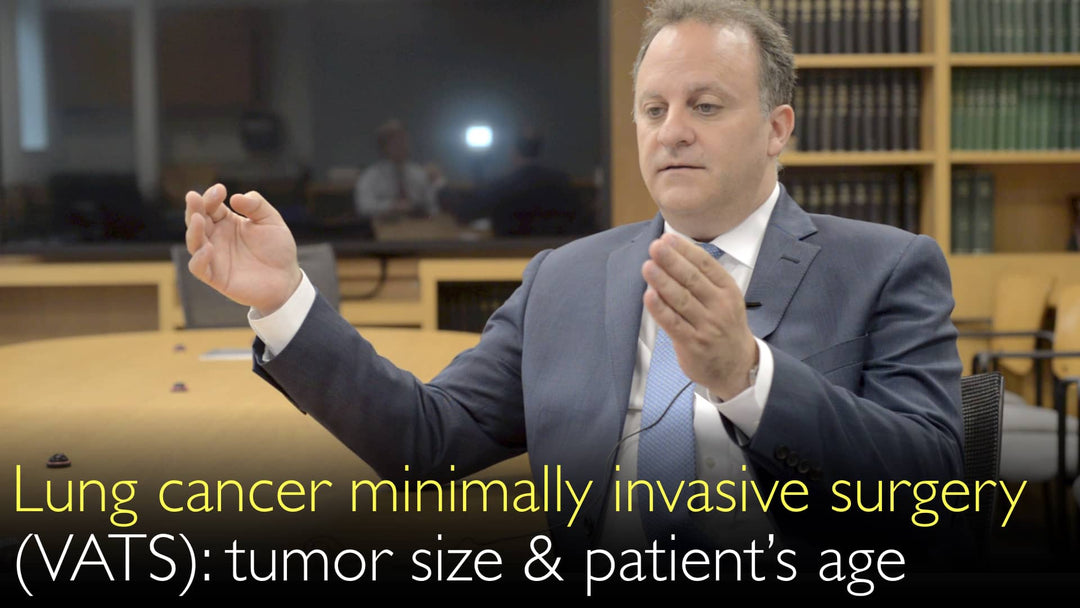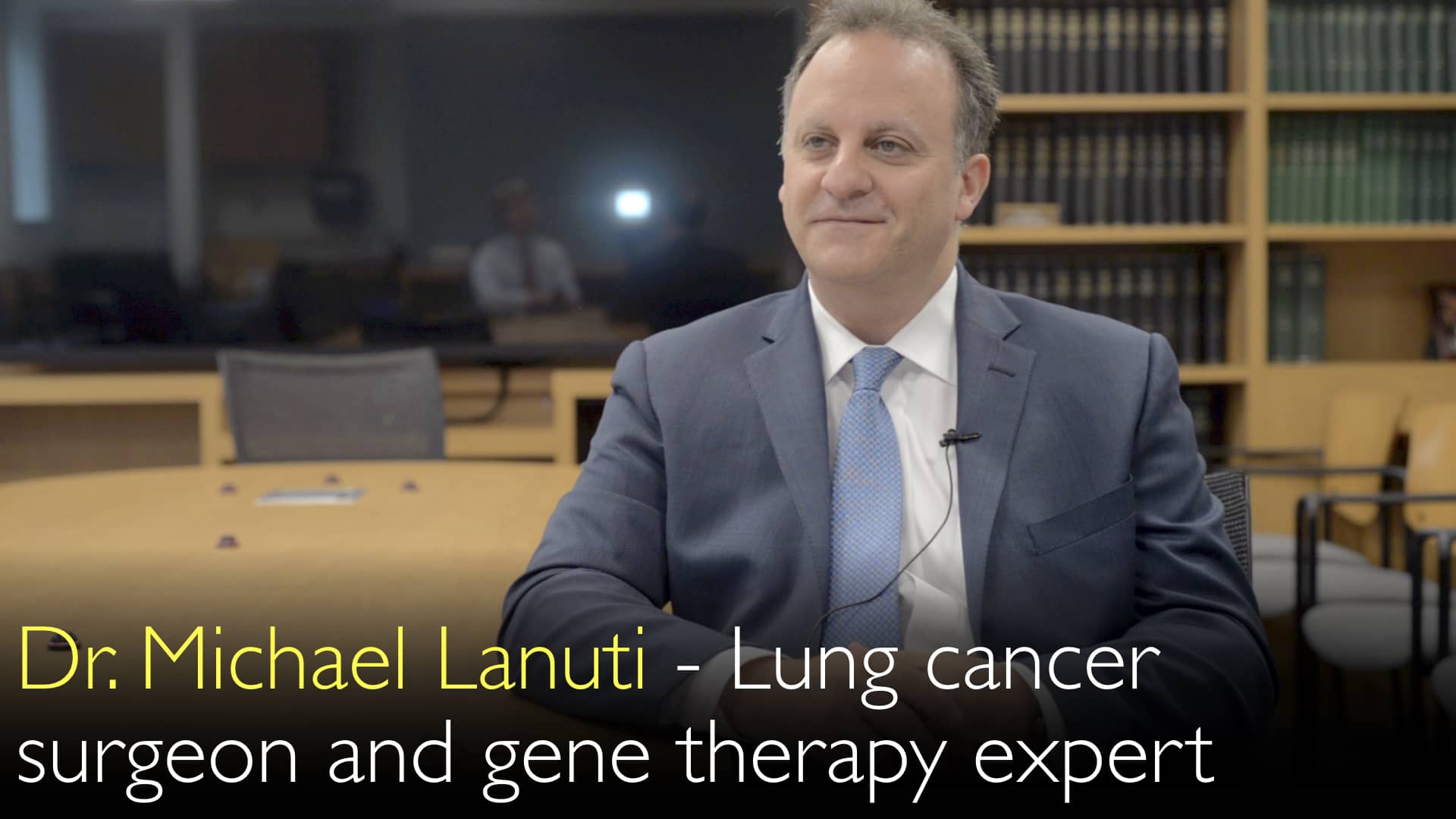Dr. Michael Lanuti, en førende ekspert inden for minimalt invasiv thorakalkirurgi, forklarer, hvordan videoassisteret thorakoskopisk kirurgi (VATS) revolutionerer behandlingen af lungekræft. Teknikken muliggør hurtigere rekonvalescens, forkorter hospitalsophold og udvider de kirurgiske muligheder for ældre patienter med små, perifert beliggende tumorer.
Minimalinvasiv lungekræftkirurgi: Fordele ved VATS og patientudvælgelse
Spring til afsnit
- Hvad er VATS-lungekirurgi?
- Ideelle kandidater til VATS
- Tumorstørrelse og -placering for VATS
- Fordele og genopretning ved VATS
- VATS til ældre patienter
- Fremtiden for VATS-teknologi
Hvad er VATS-lungekirurgi?
Videoassisteret thorakoskopisk kirurgi (VATS) er en minimalinvasiv teknik, der har revolutioneret behandlingen af lungekræft. Som dr. Michael Lanuti, MD, forklarer, anvender metoden et lille kamera og specialinstrumenter, der indføres gennem små snit i brystvæggen. Dette giver kirurger mulighed for at se inden i brysthulen på en skærm og udføre præcise lungekræftoperationer uden store, traditionelle åbne indgreb.
Udviklingen af VATS har betydet et stort fremskridt inden for thorakal onkologi. Dr. Michael Lanuti, MD, bemærker, at teknikken har forbedret behandlingen af lungekræftpatienter globalt, især ved tidlig stadie sygdom. Den minimalinvasive tilgang giver direkte fordele for patientens genopretning og det overordnede behandlingsresultat.
Ideelle kandidater til VATS
Patientudvælgelse er afgørende for et godt resultat med videoassisteret thorakoskopisk kirurgi. Ifølge dr. Michael Lanuti, MD, er de ideelle kandidater typisk patienter med tidlig lungekræft, især stadium 1-tumorer. Disse patienter har som regel små kræftknuder med minimal spredning til lymfeknuder, hvilket gør dem velegnede til denne minimalinvasive metode.
Dr. Michael Lanuti, MD, understreger, at en omhyggelig forundersøgelse er nødvendig for at vurdere, om VATS er egnet. Patienter gennemgår en grundig staging, herunder scanninger, for at evaluere tumorstørrelse og lymfeknodestatus. Denne evaluering sikrer, at kun egnede kandidater får VATS, hvilket maksimerer chancen for en vellykket kræftfjernelse og minimerer kirurgiske risici.
Tumorstørrelse og -placering for VATS
Tumorens egenskaber har stor betydning for, om videoassisteret thorakoskopisk kirurgi er egnet. Dr. Michael Lanuti, MD, præciserer, at kræftknuder mindre end tre centimeter i diameter som regel kan fjernes med VATS. Disse mindre tumorer, især når de sidder i lungens yderområder, giver kirurgerne nok plads til at arbejde effektivt med instrumenterne i brysthulen.
Tumorplacering viser sig ofte være endnu vigtigere end størrelsen for VATS-egnethed. Som dr. Michael Lanuti, MD, forklarer over for dr. Anton Titov, MD, giver perifere tumorer bedre kirurgisk adgang end centrale læsioner nær lungenhilum. Tumorer i mellemlappen kan være særligt udfordrende at arbejde med, hvilket nogle gange nødvendiggør overgang til åben kirurgi for at sikre en sikker fjernelse.
Fordele og genopretning ved VATS
Videoassisteret thorakoskopisk kirurgi giver væsentlige fordele sammenlignet med traditionel åben thorakotomi. Dr. Michael Lanuti, MD, fremhæver, at VATS-patienter typisk har kortere hospitalsophold og ofte bliver udskrevet en til to dage tidligere end ved åben kirurgi. Den hurtigere genopretning betyder, at patienterne kommer tilbage til normale daglige aktiviteter og arbejde tidligere, ofte en uge eller to.
Fordelene ved genopretningen strækker sig ud over den umiddelbare postoperative periode. Dr. Michael Lanuti, MD, understreger, at patienter, der får minimalinvasiv lungekræftkirurgi, ofte kan starte i adjuvante behandlinger som kemoterapi eller strålebehandling hurtigere. Denne tidsmæssige fordel er særlig vigtig for patienter med mere fremskreden lungekræft, der har brug for multimodal behandling for det bedste resultat.
VATS til ældre patienter
Videoassisteret thorakoskopisk kirurgi har forbedret mulighederne for kirurgi hos ældre lungekræftpatienter markant. Dr. Michael Lanuti, MD, forklarer, at traditionel åben thorakotomi hos ældre patienter medfører en betydeligt højere risiko for komplikationer. Den minimalinvasive tilgang ved VATS reducerer det kirurgiske trauma, hvilket gør lungekræftoperation mulig for patienter i 70'erne og 80'erne.
Det lavere komplikationsniveau ved VATS har ændret behandlingsparadigmet inden for geriatrisk onkologi. Som dr. Lanuti diskuterede med dr. Anton Titov, MD, muliggør teknikken vellykket kirurgi selv for patienter i 80'erne, som vist i tilfældet med dr. Titovs mor, der fik fjernet en tumor som 82-årig. Denne udvidede kirurgiske mulighed sikrer, at flere ældre patienter kan få en potentielt helbredende behandling for tidlig lungekræft.
Fremtiden for VATS-teknologi
Teknologiske fremskridt udvider fortsat anvendelsesmulighederne for videoassisteret thorakoskopisk kirurgi. Selvom der i dag er begrænsninger for større eller centralt placerede tumorer, indikerer dr. Michael Lanuti, MD, at nye instrumenter og kirurgiske teknikker kan udvide VATS-indikationerne. Den løbende udvikling af mere avancerede kameraer og fleksible instrumenter lover bedre kirurgisk præcision og kapacitet.
Fremgangen i VATS-teknologi fokuserer på at forbedre kirurgens syn og mulighed for at manøvrere instrumenter i brysthulen. Som dr. Lanuti antyder, kan disse innovationer muliggøre fjernelse af mere komplekse kræftknuder med minimalinvasive metoder. Denne teknologiske udvikling skubber fortsat grænserne for, hvad der er muligt inden for thorakalkirurgi, samtidig med at patientfordelene ved VATS bevares.
Fuld transskription
Dr. Anton Titov, MD: Videoassisteret thorakoskopisk kirurgi (VATS) til minimalinvasiv lungekræftbehandling. Hvad er fordelene ved VATS? Hvilke muligheder er der for lungekræftbehandling baseret på en patients alder?
Dr. Michael Lanuti, MD: Ja, lungekræftbehandling har virkelig udviklet sig på dette område. Verden over og i USA har en videoassisteret tilgang til fjernelse af lungekræftknuder revolutioneret, hvordan vi behandler patienter med lungekræft. Videoassisteret thorakoskopisk kirurgi (VATS) har forbedret patienternes genopretning.
Dr. Michael Lanuti, MD: Patienter, der er egnede til VATS, har generelt små lungekræftknuder, stadium 1-tumorer. De har ikke meget spredning til lymfeknuder. På den anden side har vi udvidet VATS til nogle patienter.
Dr. Michael Lanuti, MD: Nogle gange tænker vi på videoassisteret thorakoskopisk kirurgi (VATS) – målet er ikke kun for lungekræft, men også for andre sygdomme i brysthulen. I denne diskussion om lungekræft drejer det sig om knuder mindre end tre centimeter. Sådanne knuder sidder som regel i lungens yderområder.
Dr. Michael Lanuti, MD: Nogle gange er lungeadenocarcinomer større eller ligger mere centralt. Så bliver det sværere at flytte rundt på tingene i brysthulen med et kamera og små instrumenter. Derfor vælger vi ofte den traditionelle åbne teknik til større lungekræftknuder.
Dr. Michael Lanuti, MD: Nogle gange er der meget kræft i lymfeknuder omkring lungenhilum. Disse er typisk ikke egnede til en minimalinvasiv tilgang.
Dr. Anton Titov, MD: Teknologien udvikler sig for videoassisteret thorakoskopisk kirurgi (VATS) til lungekræftbehandling. Betyder det, at større tumorer vil blive tilgængelige for minimalinvasiv behandling? Eller er tumorplacering den mest begrænsende faktor for VATS?
Dr. Michael Lanuti, MD: Jeg tror, det er tumorplaceringen. Du kan have en meget stor knude i en underlap, som du kan flytte rundt i brysthulen. Du vil stadig kunne arbejde med kræften med små instrumenter.
Dr. Michael Lanuti, MD: En meget stor tumor i mellemlappen ville ikke nødvendigvis egne sig til at vende lungen frem og tilbage. Så du kan arbejde med de små instrumenter og kameraet inde i lungen.
Dr. Anton Titov, MD: Minimalinvasiv lungekræftkirurgi fører ofte til hurtigere genopretning. Måske er den mere egnet til ældre patienter. Ser du det med VATS-lungekræftkirurgi?
Dr. Michael Lanuti, MD: Det er klart, at patienter, der har gennemgået videoassisteret thorakoskopisk kirurgi (VATS), bliver udskrevet fra hospitalet en dag eller to tidligere. Sådanne patienter kan vende tilbage til daglig aktivitet eller arbejde måske en uge eller to tidligere.
Dr. Michael Lanuti, MD: De kan starte yderligere lungekræftbehandling som kemoterapi. De har tendens til at kunne starte kemoterapi eller strålebehandling hurtigere. Det er en kæmpe fordel, hvis du har patienter med mere end stadium 1 lungekræft.
Dr. Michael Lanuti, MD: Når det gælder ældre patienter, mener jeg, at en åben operation, en thorakotomi, hos en ældre patient har flere konsekvenser. Det er bedst at anvende en minimalinvasiv teknik.
Dr. Michael Lanuti, MD: Fjernelse af en lungelap med en åben teknik har klart højere morbiditet. Ældre lungekræftpatienter får flere komplikationer. Med færre komplikationer kan vi nu anvende lungekirurgi på patienter i 70'erne og 80'erne. Vi frygter kirurgi mindre end før.
Dr. Anton Titov, MD: Hvilket indikerer, hvordan min mor var 82 år på tidspunktet for hendes lungekræftoperation. Du kunne udskrive hende i god tilstand efter kun seks dage. Så jeg tror, det er et godt eksempel.





